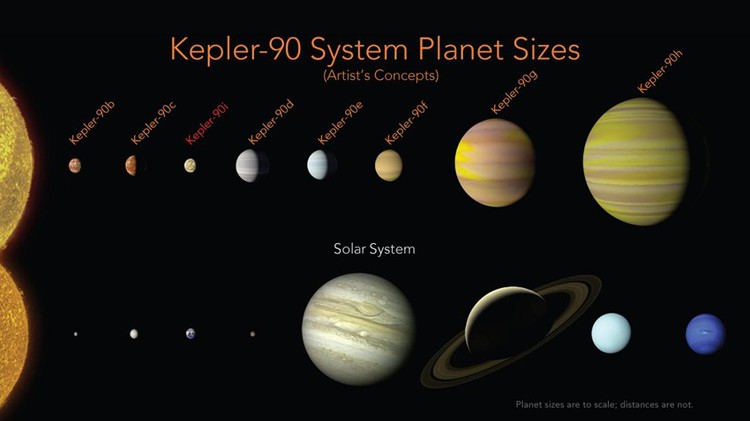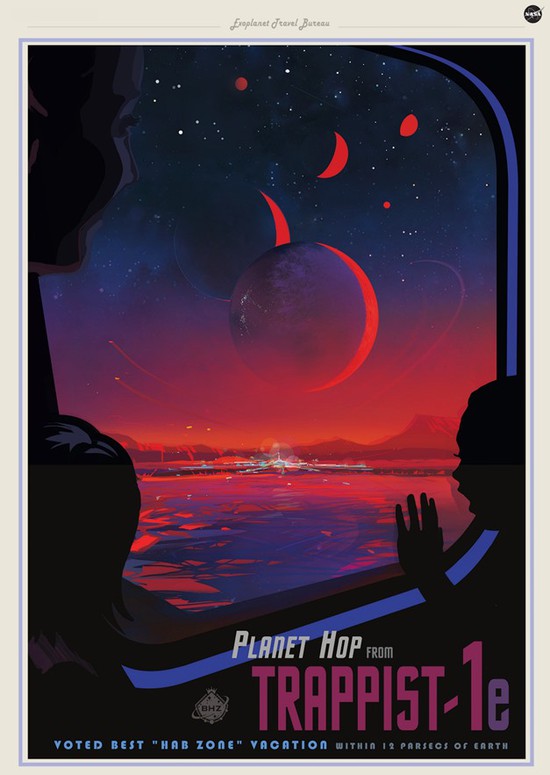First Grade, Exoplanets STEM Activities for Kids (0 results)
An exoplanet or extrasolar planet is a planet outside the Solar System. The first confirmation of an exoplanet detection occurred in 1992. As of 1 October 2019, there are 4,118 confirmed exoplanets in 3,063 systems, with 669 systems having more than one planet.

Figure 1. Artist's conception of exoplanets in Kepler-90 system compared to solar system.

Figure 2. A NASA travel poster "spoof." Discovered in October 2013 using direct imaging, PSO J318.5-22 belongs to a special class of planets called rogue, or free-floating, planets. Wandering alone in the galaxy, they do not orbit a parent star. Not much is known about how these planets come to exist, but scientists theorize that they may be either failed stars or planets ejected from very young systems after an encounter with another planet. These rogue planets glow faintly from the heat of their formation. Once they cool down, they will be dancing in the dark. |
There are many methods of detecting exoplanets. Transit photometry and Doppler spectroscopy have found the most, but these methods suffer from a clear observational bias favoring the detection of planets near the star; thus, 85% of the exoplanets detected as of 2019 are inside the tidal locking zone. In several cases, multiple planets have been observed around a star. About 1 in 5 Sun-like stars have an "Earth-sized" planet in the habitable zone. Assuming there are 200 billion stars in the Milky Way, it can be hypothesized that there are 11 billion potentially habitable Earth-sized planets in the Milky Way, rising to 40 billion if planets orbiting the numerous red dwarfs are included.
There are planets that are so near to their star that they take only a few hours to orbit and there are others so far away that they take thousands of years to orbit. Some are so far out that it is difficult to tell whether they are gravitationally bound to the star. Almost all of the planets detected so far are within the Milky Way. Nonetheless, evidence suggests that extragalactic planets, exoplanets farther away in galaxies beyond the local Milky Way galaxy, may exist. The nearest exoplanet is Proxima Centauri b, located 4.2 light-years (1.3 parsecs) from Earth and orbiting Proxima Centauri, the closest star to the Sun.
The discovery of exoplanets has intensified interest in the search for extraterrestrial life. There is special interest in planets that orbit in a star's habitable zone, where it is possible for liquid water, a prerequisite for life on Earth, to exist on the surface. The study of planetary habitability also considers a wide range of other factors in determining the suitability of a planet for hosting life.
Besides exoplanets, there are also rogue planets, which do not orbit any star. These tend to be considered as a separate category, especially if they are gas giants, in which case they are often counted as sub-brown dwarfs, like WISE 0855−0714. The rogue planets in the Milky Way possibly number in the billions (or more). [Source: Wikipedia https://en.wikipedia.org/wiki/Exoplanet]

|
| Figure 3. Another NASA travel poster "spoof." Some 40 light-years from Earth, a planet called TRAPPIST-1e offers a heart-stopping view: brilliant objects in a red sky, looming like larger and smaller versions of our own moon. But these are no moons. They are other Earth-sized planets in a spectacular planetary system outside our own. These seven rocky worlds huddle around their small, dim, red star, like a family around a campfire. Any of them could harbor liquid water, but the planet shown here, fourth from the TRAPPIST-1 star, is in the habitable zone, the area around the star where liquid water is most likely to be detected. This system was revealed by the TRAnsiting Planets and PlanetIsmals Small Telescope (TRAPPIST) and NASA's Spitzer Space Telescope. |
|
Select a resource
Sort by
|
No results.
|
Other Resources
- https://exoplanets.nasa.gov
- http://archive.stsci.edu/index.html
- https://nitarp.ipac.caltech.edu/page/other_epo_programs




